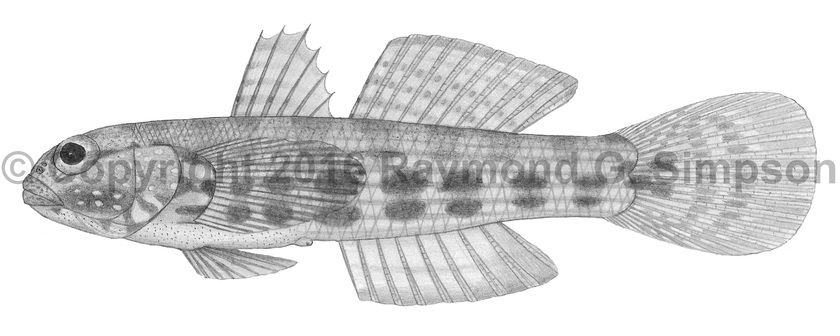
Common Name
Twinspotted Frillfin Goby
Year Described
Tornabene, Baldwin, & Pezold, 2010
Identification
Dorsal Fin: VI, 10
Anal Fin: I, 8
Pectoral Fin: 17-18
Caudal Rays: 15-17 upper, 14-15 lower lobe (all types)
Scale Rows: 36-38
Pre-dorsal Scales: 17-20
Body of typical shape for the gobies but robust. Eye large sized; a little more than snout length. Upper jaw less than 11% of SL. Pectoral fin extends beyond rear margin of first dorsal. Upper four pectoral rays separate from membrane; bifurcate but the fourth sometimes multifurcated. Pelvic fins fully fused into disk. Pelvic fins reach or barely short of anus. Caudal fin rounded. Body fully scaled with scales extending forward to past the pre-opercular margin. Cheek and opercle unscaled.
Color
Body pale basally with numerous thin horizontal brown stripes following scale rows. Lower half of body with two strong and conspicuous rows of dark blotches: first from pectoral base to tail and the second following ventrum to the caudal peduncle. Blotches are roughly in line but slightly oblique in relation to each other. Dorsum with lighter pattern and faint irregular blotches or saddles. Belly pale with fine speckling. Head and trunk with dense pattern of dark markings giving al overall dark appearance with white spots and lines. Eye dark. Spiny dorsal with 2-3 horizontal lines and a yellowish edge. Soft dorsal fin with oblique lines of brown spots and a pale margin. Caudal fin with brown spotting along rays. Case of caudal fin with three closely spaced black spots. Anal fin with a dark membrane. Pelvic fin dusky brown. Pectoral fin with faint spotting along rays and blotches at the base.
Size
Maximum size to 47mm SL.
Habitat
Inhabits low energy shallow coastlines in seagrass beds, sandy shores, and sheltered hardbottoms.
Range
Known from off Florida, Puerto Rico, and Brazil. Likely widespread in the Caribbean Sea.
References
Lima-Filho, P.A., R. de Souza Rosa, A.D.S. de Souza, G.W.W.F. da Costa, C. de Oliveira, & W.F. Molina. 2016. Evolutionary diversification of Western Atlantic Bathygobius species based on cytogenetic, morphologic and DNA barcode data. Reviews in Fish Biology and Fisheries: 26(1), 109-121.
Tornabene, L., C. Baldwin, L.A. Weigt, and F. Pezold. 2010. Exploring the diversity of western Atlantic Bathygobius (Teleostei: Gobiidae) with cytochrome c oxidase-I, with descriptions of two new species. Aqua: 16(4), 141-170.
Tornabene, L. and F. Pezold. 2011. Phylogenetic analysis of Western Atlantic Bathygobius (Teleostei: Gobiidae). Zootaxa: 3042, 27-36.
Other Notes
Occupies a clade sister to the Bathygobius soporator group in the phylogeny of Tornabene & Pezold (2011) but nested inside the B. antilliensis group in the phylogeny of Lima-Filho et al. (2016) but the nodes are poorly resolved. Bathygobius geminatus and B. mystacium are fairly distinctive species and their relationship to Indo-Pacific Bathygobius need to be studied.
Lima-Filho et al. (2016) found that populations identified as B. mystacium off Brazil were actually this species. The only Bathygobius found off Brazil are this species, B. sorporator, and an undescribed species allied with B. antilliensis.